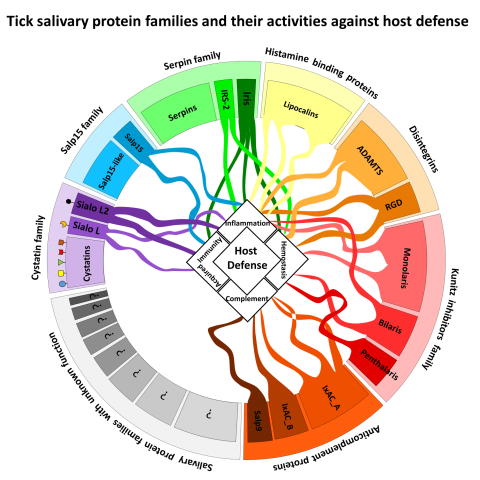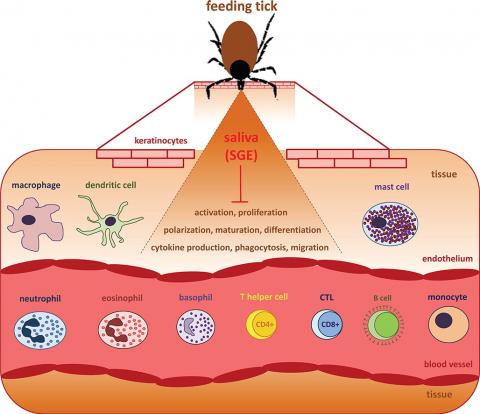Novel anti-hemostatics and immunomodulators from tick saliva
INTRODUCTION:
Hard ticks are long term blood feeders. In order to feed successfully, ticks secrete into their saliva hundreds of different effectors with anti-hemostatic, anti-inflammatory, immunossupressive and immunomodulatory activities, targeting many different pathways. These molecules can be used for the development of novel, highly specific drugs.
TECHNOLOGY (INVENTION) DESCRIPTION:
Tick salivary glands secrete large number of proteins into tick saliva that help to overcome host defense by altering almost every possible process of immune system. Thanks to transcriptomics, there are large, publically available databases of tick secreted salivary genes, coding for potential immunomodulators. Tick salivary glands thus can serve as a library of candidates for novel drugs. By using reverse genetics approach, we will prepare tick proteins in recombinant and active form. We will create an experimental pipeline, consisting of several functional in vitro and in vivo assays, in which we will test the proteins for their activities. By setting up such a pipeline, we will be able to identify and characterize many patentable immunomodulators with potential use in the medicine.
ADVANTAGES OVER EXISTING SOLUTIONS:
In the search for novel drugs, screening of thousands of synthetic compounds is often used. These compounds can display variable efficacy and serious side effects. During long term co-evolution with their hosts, ticks developed and improved mechanisms, by which they effectively manipulate host defensive mechanisms, such as platelet aggregation, coagulation, complement, inflammation, pain and antigen specific immunity. We can take an advantage of having access to this rich source of natural pharmacoactive molecules, activities of which were being refined for millions of years. By narrowing our focus on ticks, we can significantly improve and speed up the process of searching for novel drugs.
DEVELOPMENT STATUS (STAGE):
available gene databases, many identified immunomodulators and antihemostatics, available methodology for the project
PUBLICATIONS:
Chmelař et al.: All For One and One For All on the Tick-Host Battlefield. Trends Parasitol. 2016 May;32(5):368-77. Kazimírová M and Štibrániová I.: Tick salivary compounds: their role in modulation of host defences and pathogen transmission. Front Cell Infect Microbiol. 2013 Aug 20;3:43. Chmelar et al.: Tick salivary secretion as a source of antihemostatics. J Proteomics. 2012 Jul 16;75(13):3842-54. Morais et al.: Amblyomin-X induces ER stress, mitochondrial dysfunction, and caspase activation in human melanoma and pancreatic tumor cell. Mol Cell Biochem. 2016 pr;415(1-2):119-31.
IP PROTECTION STATUS:
Related patents of other authors : WO2005063812 A3, WO 2001058941 A1, WO2010107991A3, WO 2016204696 A1, US 8324161 B2
TECHNOLOGY / IP OWNERS :
Some tick proteins and applications are patented, but it is only negligible portion of what is possible in this field. Usually, only protein from single tick species is patented, not its homologues from other species.


More information
More information is available upon signing a CDA / NDA (Confidential Disclosure Agreement / Non-Disclosure Agreement)